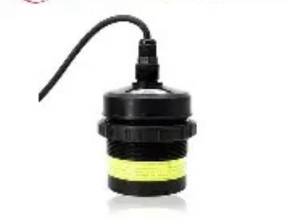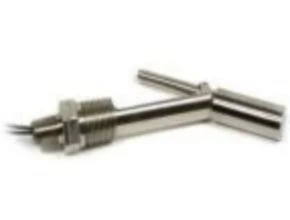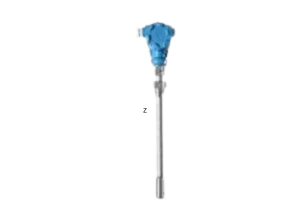Overview
External Non-contact Level Meter (Ultrasonic Level Sensor) is a kind of instrument which measures the liquid level inside the tank from the outside of the tank. The product realizes completely isolated measurements.
The External Ultrasonic Level sensor adopts the principle of ultrasonic echo ranging, uses the special probe externally attached to the container to collect ultrasonic signals, and uses the special algorithm to accurately calculate the liquid level position in the container by emitting an ultrasonic pulse from the transducer, then measuring the time required for the echo to reflect from the liquid surface and return to the transducer. The powerful electronics measure the time of the round trip pulse and, by knowing the speed of sound, calculate the distance..
The calculated liquid level value is displayed locally and the remote signal is output. The instrument can output the result to the control center through (4 ~ 20) mA analog signal, Hart, RS-485, and other interfaces, and can also be debugged online through Hart, RS-485 / Modbus, infrared, and other interfaces.
Like the picture, Measure the liquid level, the sonar wave signal from the probe to launch out, after the liquid level reflected, the probe detects an echo signal. Echo signal by proprietary algorithm to calculate the time (t), the system can calculate the liquid level value according to the formula.
External Non-contact Level Meter Advantages
- No leakage risk.
- Easy, fast, and safe installation
- Multiple calibrations
- Power Switching.
- Wide application range
- Can be used in a variety of harsh environments.
- A liquid that can be measured at any pressure.
- It can measure the most corrosive liquid.
- The highly toxic liquid can be measured.
- The inflammable, explosive, leaky, and contaminated liquid can be measured.

The External non-contact level sensor provided by SKE adopts a sonar ranging principle, which measures the liquid level without tank break-in. This solution avoids the indicator block, hard to clean & maintenance that frequently appears on the magnetic level meters.
These Non-contact ultrasonic level sensors provide long-time accurate results without leakage risk. There was no shutdown during installation, bringing significant time and cost savings for our clients.
When measuring poisonous, corrosive, pressurized, flammable, explosive, volatile, and leaky liquids, the measuring head and instrument are outside the container, so the installation, repair, and maintenance operation should not touch the liquid and gas in the tank, which is very safe. There is no possibility of leakage even if the instrument is damaged or under repair.
Technical Specifications
- Max Measuring range: 30 m
- measuring error: ±1%FS
- Transfer volume: ±100m
- Frequency range: 20k-400k
- Signal output : (4~20 )mA, HART,MAX 500?
- Communication : RS-485,IR,HART,
- Environment temperature gauge: 20?~+70?,-40?~+70?
- Environment temperature probe: 50?~+100?,60?~330?
- Ambient humidity: (0~100%)RH
- Explosion-proof sign: Exd II CT6
- Enclosure protection grade: IP67
- Power supply: DC 24V
- The cable length: 5m,10m,15m,20m,25m,30m
External Non-Contact Ultrasonic Level Sensor Application
A Non-contact External Ultrasonic Level sensor is currently used in LPG tanks, liquid ammonia, 98%sulfuric acid, etc It is in use everywhere where the high of liquids in tanks has to be measured continuously and contactless.
Application possibilities for radar gauges can be found in almost all areas of industry. Sewage treatment plants and water purification plants in particular, but also other environmental engineering facilities as well as power generating stations now rely on cost-effective radar sensors for continuous level measurement.
External Non-contact Level Meter Measured substance
In general, the dynamic viscosity of the measured medium is required to be less than 10 MPa. S. When 10 MPa. S < dynamic viscosity < 30 MPa. S, the measurement range may be reduced and the blind area may be increased. It cannot be measured when the dynamic viscosity is > 30 MPa. S. (1 MPa. S = 1 CP).
There should be no dense bubbles in the liquid; there should not be a large number of suspended substances in the liquid, such as crystals; there should not be a large number of sedimentary substances in the liquid, such as mud and sand. The temperature of the measured medium shall be within – 50 ? ~ 100 ?.
| Butadiene | Propylene | LPG | Propane |
| Liquid ammonia | Methyl alcohol | Methylbenzene | Butadiene |
| 98% sulfuric acid | Diesel | Gasoline | Naphtha |
| Liquid chlorine | Iso-butane | Epoxypropane | Acetone |
| Sulfuretted hydrogen | Styrene | N-butane | Xylene |
| Silicon tetrachloride | Tert-butylamine | Chloroform | Acetaldehyde |
| Hydrogen fluoride | Hydrofluoric acid | Butane | Hydroxy nickel |
Other Article:
- Non Metal Electromagnetic Flow Meter
- Flow Measurement
- Type of Flow Meter
- Flow Meter Indonesia
- Aplikasi dan Jenis Radar Level Sensor






